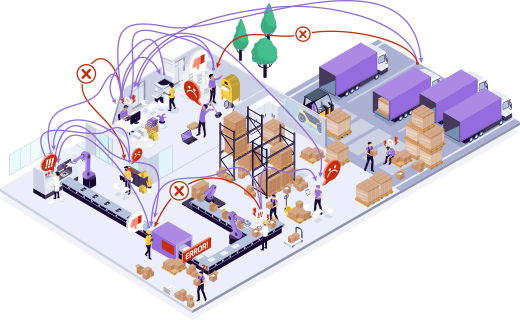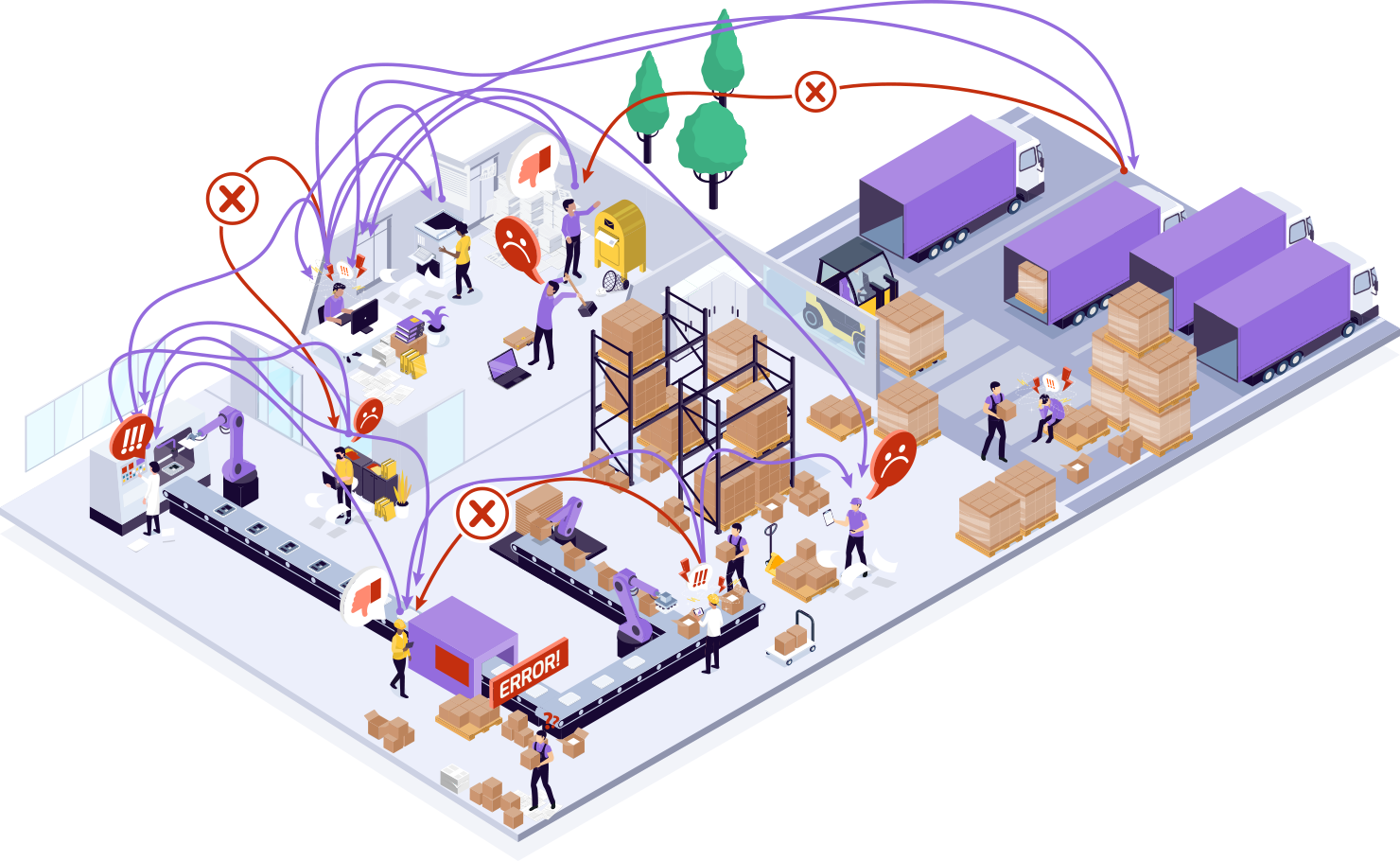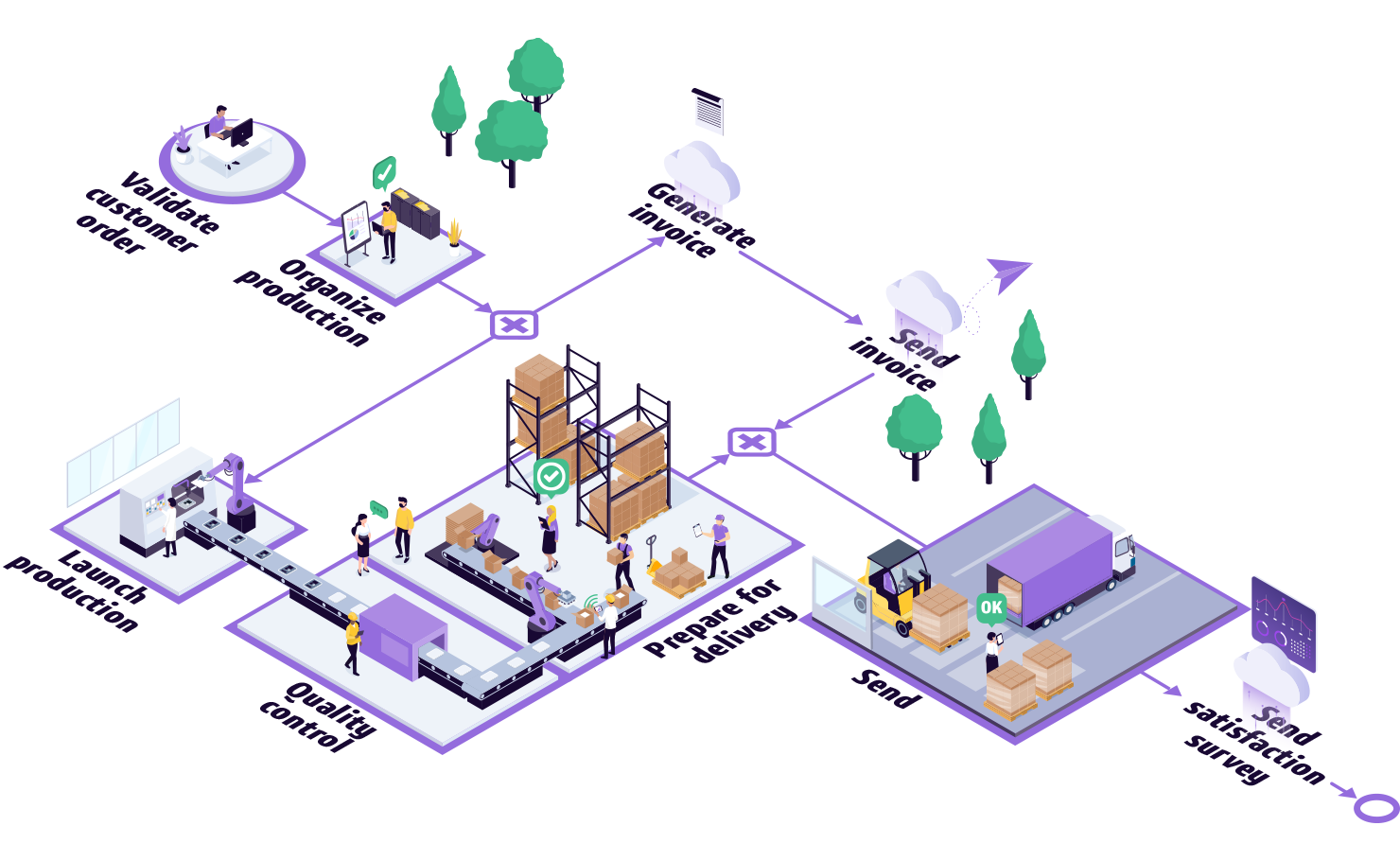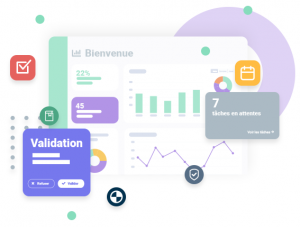
Understanding BPM
How will business process management improve your operations? Discover the benefits of Iterop, the BPM solution.
The BPM (Business Process Management) approach aims to improve the performance of a business by analyzing and streamlining its processes.
This article covers the basics to help you fully understand BPM. If you wish to learn more, we encourage you to read the Practical Guide to BPM.
What is a business process?
Business processes are the set of day-to-day activities required to perform each job. They consist of a series of tasks and actions, sometimes complex, that your employees must accomplish in order to achieve a determined result for example:
- managing customer complaints,
- HR onboarding
- launching products,
- tracking purchase requests,
- managing the quality process,
- managing temporary staff,
- publishing requests for proposals.
- …
For a given process it is possible to have several procedures: the sequence of activities is similar, but the resources related to its execution may vary (e.g. from one subsidiary or department to another).
The workflow, on the other hand, corresponds to the representation and computerized management of all the tasks to be accomplished associated with the different parties involved in carrying out a process.
What is BPM?
 BPM (Business Process Management) provides a way to represent the activities of an organization: its processes. It highlights human interactions and data exchanges with existing information systems. By defining the steps, actions, and exchanges, the company gains a powerful mechanism for managing its activities.
BPM (Business Process Management) provides a way to represent the activities of an organization: its processes. It highlights human interactions and data exchanges with existing information systems. By defining the steps, actions, and exchanges, the company gains a powerful mechanism for managing its activities.
It provides a broader view and highlights performance issues. The idea is to ensure that its processes are implemented to meet customer needs with the highest level of performance.
BPM provides a way to understand how the various parts of the company function: Quality, Purchasing, IT, Marketing, HR, Sales, HelpDesk etc. and lets you analyze and streamline the processes in place in order to improve their performance.

Representation of a company’s flows

Representation of a flow as a structured process
And how does BPMN fit into all this? BPMN (Business Process Model and Notation) is an internationally recognized standard for graphically modeling an organization’s business processes. It provides a comprehensive and simple graphical notation to represent all the possible actions of a business process.
What does BPM bring to the table?
BPM has two prominent roles: it is both a business strategy but also a powerful management mechanism for the company. It provides new solutions by directly addressing the core performance issues.
Business Process Management (BPM) creates value for the company by improving its performance, productivity, employee efficiency, and customer service quality. All these improvements are a direct result of streamlining business processes.
The objective of BPM is to bring total visibility on the activity and exchanges within the company. It consists of reducing the rate of human error and communication breakdowns within those processes, as well as allowing the various stakeholders to focus on tasks with higher added value.
The purpose of all this? To analyze and regularly adapt the company’s business processes, workflows, and procedures in line with identified requirements to enhance the company’s performance or service quality.
BPM generates a host of benefits. Those benefits depend on the nature of the modeled processes.
Visibility: a well-described process helps the users understand the issues at stake so they can contribute more effectively.
Cost-effectiveness: BPM makes it possible to reduce lead times, accelerate decision making, optimize costs, and in so doing maximize efficiency and the outcome for the company.
Efficiency : The current economy continuously strives to do more with less. The principles of BPM help improve productivity.
Traceability: progress tracking (who? what? when? how? why? …) is made easier by setting up monitoring indicators, so that any problems identified can be reported immediately.
Agility: the identification and correction of dysfunctions encountered are major issues in BPM. The ability to adapt the modeled processes in real time according to the identified constraints and exceptions generates a new agility.
What is BPMS?
BPMS stands for “Business Process Management Suite”. It is a software suite designed to facilitate the BPM approach in companies and, above all, to automate the defined processes as much as possible.
BPM software allows processes to be defined and represented graphically (process documentation), rolled out, and executed automatically while being integrated and connected to existing software and systems (process execution). In addition, BPM software provides an interface to track, monitor, and analyze integrated processes in real time to improve their results (process monitoring and optimization).
BPM software usually includes several components:
- A process modeling tool, which is used to graphically represent the company’s business processes;
- A workflow engine responsible for bringing the process to life and automating its execution according to the defined conditions;
- An interface allowing the parties involved in a process to be alerted and to perform the tasks incumbent upon them, generally with the help of computer forms to be filled out;
- A real-time monitoring interface to manage and drive processes as they progress;
- An interface to adapt and streamline the processes.
Additional components may include:
- Tools to facilitate integration, i.e. interfaces (APIs) and connectors to integrate the BPM software with the existing information system;
- A simulation interface to simulate and optimize processes even before they are rolled out to the users;
- Customizable steering and reporting tools to design dashboards featuring precise indicators (KPIs) to help managers make the right decisions quickly. This is called BAM (Business Activity Monitoring).
What does Iterop bring to the table?
Iterop is a BPM software solution available online (100% web-based) designed for business managers who want to better control their processes and be self-reliant in taking on that task. Based on three principles facilitating self-reliance, Iterop has been developed to be: easy to use, quick to set up, and a tool for making processes more agile (bestowing the ability to quickly streamline defined processes).

Including all the standard components of a BPM software solution, it will enable you to: easily manage all your business processes, graphically model your business processes, maintain real-time control of your exchanges, and monitor the overall performance of your business by means of defined performance indicators.
You can also improve, simplify and optimize your processes with just a few clicks, in line with the identified constraints, adapting the process without any service discontinuity and in an agile way.

